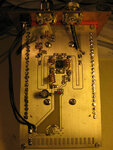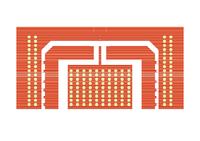atlantis7
Member level 2
Hi
The task is to build a UHF amplifier in the range of 430-440 MHz using the low cost mosfet RD15HVF1. For this device there is no nonlinear model and unfortunately will most likely never be.
A tool called FAST (Fast Amplifier Synthesis Tool) gave me the attached schematic, the power and bias circuit are added by hand.
The problem is that the performance is from bad to worse whatever I do. For the capacitors I used trimmers and also changed them for different ones but whatever I do I can't get an output power of much more than twice the input power.
What's the best way to troubleshoot this? I'm somehow losing the patience with just the trial and error replacing method.
Regards
Martin
The task is to build a UHF amplifier in the range of 430-440 MHz using the low cost mosfet RD15HVF1. For this device there is no nonlinear model and unfortunately will most likely never be.
A tool called FAST (Fast Amplifier Synthesis Tool) gave me the attached schematic, the power and bias circuit are added by hand.
The problem is that the performance is from bad to worse whatever I do. For the capacitors I used trimmers and also changed them for different ones but whatever I do I can't get an output power of much more than twice the input power.
What's the best way to troubleshoot this? I'm somehow losing the patience with just the trial and error replacing method.
Regards
Martin


